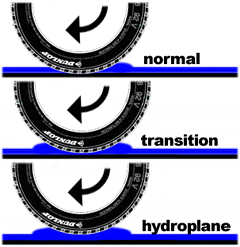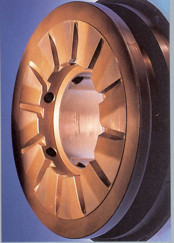Boundary Lubrication
Boundary lubrication in marine diesel engine bearings occurs during start up and stopping, relatively slow speeds, high contact pressures, and with less than perfectly smooth surfaces. As running conditions become more severe such as with rough surfaces, and high contact pressures, wear becomes a severe problem to the system.
With mineral oil, it is possible to create a lubricant that forms a surface film over the surfaces, strongly adhering to the surface. These films are often only one or two molecules thick but they can provide enough of a protection to prevent metal to metal contact.
Hydrodynamic Lubrication
Fluid film or hydrodynamic lubrication is the term given when a shaft rotating in a bearing is supported by a layer or wedge of oil so that the shaft is not in contact with the bearing material.
Hydrodynamic lubrication was first researched by Osborne Reynolds (1842-1912).When a lubricant was applied to a shaft and bearing, Reynolds found that the rotating shaft pulled a converging wedge of lubricant between the shaft and the bearing. He also noted that as the shaft gained velocity, the liquid flowed between the two surfaces at a greater rate. This, because the lubricant is viscous, produces a liquid pressure in the lubricant wedge that is sufficient to keep the two surfaces separated. Under ideal conditions, Reynolds showed that this liquid pressure was great enough to keep the two bodies from having any contact and that the only friction is the system was the viscous resistance of the lubricant. The operation of hydrodynamic lubrication in journal bearings is illustrated below. Before the rotation commences the shaft rests on the bearing surface. When the rotation commences the shaft moves up the bore until an equilibrium condition is reached when the shaft is supported on a wedge of lubricant. The moving surfaces are then held apart by the pressure generated within the fluid film. Journal bearings are designed such that at normal operating conditions the continuously generated fluid pressure supports the load with no contact between the bearing surfaces. This operating condition is known as thick film lubrication and results in a very low operating friction and extremely low bearing load
Viscosity of the lubricant is an important feature. The higher the viscosity, the higher the friction between oil and shaft, but the thicker the hydrodynamic film. However friction generates heat, which will reduce the viscosity, the thickness of the film and may result in metal to metal contact. Using an oil with a low initial viscosity will also result in a reduced oil film thickness. We have to be very careful that the distance between the two surfaces is greater than the largest surface defect. The distance between the two surfaces decreases with higher loads on the bearing, less viscous fluids, and lower speeds. Hydrodynamic lubrication is an excellent method of lubrication since it is possible to achieve coefficients of friction as low as 0.001 (m=0.001), and there is no wear between the moving parts. However because the lubricant is heated by the frictional force and since viscosity is temperature dependent, additives to decrease the viscosity's temperature dependence are used. The oil of course is cooled before it is pumped back through the engine.
Thrust Bearing
The following related articles are available in the Members Section Thickwall Bearings Main Bearing Design Bottom End Bearing design Crosshead Bearing Design The Piston pin Bearing The Thrust Bearing Bearing Faults |




